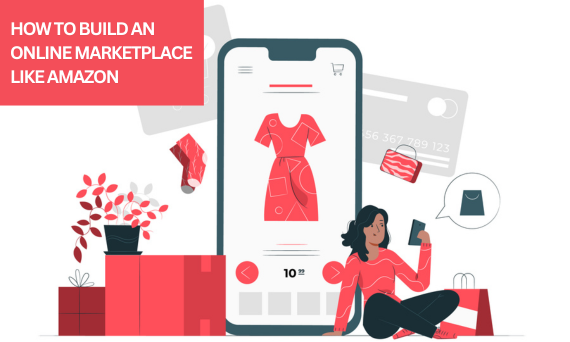The e-commerce industry is booming, with global online sales expected to reach $6.3 trillion by 2024. Amazon, the world’s largest online marketplace, dominates this space with its vast product selection, seamless user experience, and efficient logistics.
Building an online marketplace like Amazon is a complex but rewarding venture. Whether you’re an entrepreneur, a startup, or an enterprise looking to expand, this guide will walk you through the key steps, features, and best practices to create a successful multi-vendor e-commerce platform.
Understanding Online Marketplaces & Amazon’s Business Model
An online marketplace is a digital platform where multiple sellers list and sell products to buyers. Unlike traditional e-commerce stores (like Shopify), marketplaces do not own inventory—they act as intermediaries connecting buyers and sellers.
Choosing the Right Online Marketplace Model
Before building your marketplace, you need to decide on the business model that aligns with your goals:
- Inventory-Based vs. Marketplace Model
- Inventory-based (like Walmart): The platform owns and sells its own products.
- Marketplace model (like Amazon): Third-party sellers list products, and the platform takes a commission.
- Hybrid model (Amazon’s approach): A mix of both (Amazon sells its own products while also hosting third-party sellers).
- Niche vs. General Marketplace
- Niche marketplaces (Etsy, Zappos) focus on a specific category (handmade goods, shoes).
- General marketplaces (Amazon, eBay) sell everything from electronics to groceries.
- Revenue Models
- Commission-based: Charge sellers a percentage of each sale (Amazon takes 8-15% per transaction).
- Subscription fees: Sellers pay a monthly fee to list products (e.g., Shopify).
- Listing fees: Charge per product listing.
- Advertising & promotions: Offer paid ads for better seller visibility.
Amazon’s Marketplace Business Model: How It Works
Amazon’s success comes from its scalable, seller-friendly, and customer-centric approach. Here’s how it operates:
- Fulfillment by Amazon (FBA): Sellers ship products to Amazon’s warehouses, and Amazon handles storage, packing, and shipping.
- Amazon Prime: Subscription-based loyalty program offering fast shipping, exclusive deals, and streaming services.
- Third-Party Sellers: Over 60% of Amazon’s sales come from independent sellers.
- Advertising Revenue: Sellers pay for sponsored product ads to boost visibility.
Core Features of an Online Marketplace Like Amazon
To compete with Amazon, your marketplace must offer seamless buyer experiences, powerful seller tools, and a scalable infrastructure. Visit: https://zipprr.com/amazon-clone/
1. Creating a Seamless Buyer Experience
AI-Powered Search & Personalization
- Smart search with autocomplete, filters, and voice search.
- Personalized recommendations based on browsing history (e.g., “Customers who bought this also bought…”).
Transparent Reviews & Social Proof
- Verified buyer reviews to build trust.
- Ratings & Q&A sections to help shoppers make informed decisions.
Secure & Fast Checkout Experience
- One-click ordering for returning customers.
- Multiple payment options (credit cards, PayPal, digital wallets).
- Fraud detection to prevent scams.
2. Empowering Sellers with Robust Tools
User-Friendly Seller Dashboards & Inventory Management
- Easy product uploads via CSV files or API integrations.
- Real-time inventory tracking to avoid overselling.
Advertising & Promotions for Increased Visibility
- Sponsored product ads (pay-per-click model).
- Discount & coupon management to boost sales.
3. Building a Scalable & Secure Marketplace Infrastructure
Multi-Channel Customer Support
- 24/7 live chat, email, and phone support.
- AI chatbots for instant responses.
Cloud Hosting & High-Performance Servers
- Amazon Web Services (AWS) ensures scalability.
- Load balancing to handle traffic spikes.
Best Practices on How to Build an Online Marketplace Like Amazon
1. Defining a Sustainable Business Model
- Decide on revenue streams (commissions, subscriptions, ads).
- Offer competitive seller fees to attract vendors.
2. Choosing the Right Technology Stack
- Frontend: React.js, Angular, or Vue.js for a responsive UI.
- Backend: Node.js, Python (Django), or Ruby on Rails.
- Database: PostgreSQL or MongoDB.
- Payment Gateways: Stripe, PayPal, or Razorpay.
3. Essential Components of a Marketplace Tech Stack
- Product catalog management (categories, filters).
- Order & payment processing (secure transactions).
- Seller & buyer dashboards (analytics, order tracking).
4. Leveraging AI & Automation
- AI-driven recommendations to boost sales.
- Automated fraud detection for secure transactions.
5. Capitalizing on Data Analytics
- Track user behavior to optimize UX.
- Use sales forecasting to manage inventory.
6. Prioritizing Omnichannel Experiences
- Mobile app & responsive web design.
- Social commerce integration (Instagram, Facebook Shops).
The Truth Behind Launching a Successful Amazon-like Marketplace
Challenges You’ll Face
- High competition (standing out in a crowded market).
- Logistics & fulfillment (scaling delivery networks).
- Building trust (attracting both buyers and sellers).
Key Success Factors
- Exceptional UX (fast loading, easy navigation).
- Strong seller onboarding (incentives, low fees).
- Aggressive marketing (SEO, PPC, influencer partnerships).
Case Studies of Successful Marketplaces
- eBay: Auction-based model with global reach.
- Walmart Marketplace: Leveraging retail giant’s logistics.
- Etsy: Niche focus on handmade & vintage items.
FAQ
1. What is a multi-vendor marketplace?
A platform where multiple sellers list products (e.g., Amazon, eBay).
2. What technology is Amazon built on?
- Frontend: React
- Backend: Java, C++, Perl
- Cloud: AWS
- Database: DynamoDB, Oracle
3. How long does it take to build an e-commerce platform?
- MVP (3-6 months)
- Full-scale marketplace (1-2 years)
4. How much does it cost to create a website like Amazon?
- Basic MVP: 50,000−50,000−100,000
- Enterprise-level: $500,000+
Conclusion
Building an Amazon-like marketplace requires strategic planning, advanced technology, and relentless execution. By focusing on user experience, seller tools, and scalability, you can create a platform that competes in the booming e-commerce industry.
Ready to start? Partner with an experienced development team or use marketplace SaaS solutions like Sharetribe or Magento to accelerate your launch.














































